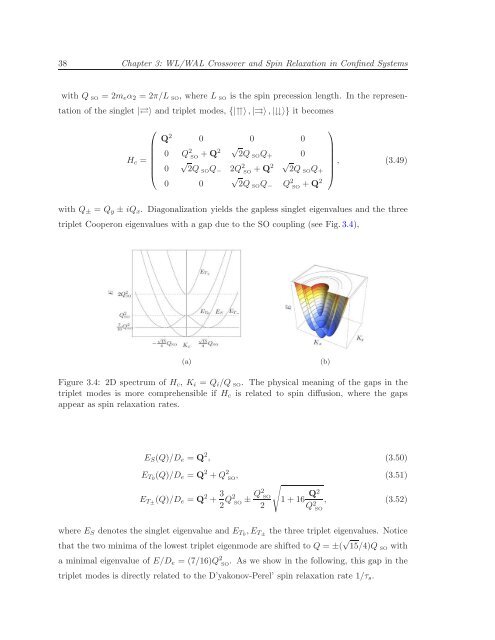Itinerant Spin Dynamics in Structures of ... - Jacobs University
Itinerant Spin Dynamics in Structures of ... - Jacobs University
Itinerant Spin Dynamics in Structures of ... - Jacobs University
Create successful ePaper yourself
Turn your PDF publications into a flip-book with our unique Google optimized e-Paper software.
38 Chapter 3: WL/WAL Crossover and <strong>Sp<strong>in</strong></strong> Relaxation <strong>in</strong> Conf<strong>in</strong>ed Systems<br />
with Q SO = 2m e α 2 = 2π/L SO , where L SO is the sp<strong>in</strong> precession length. In the representation<br />
<strong>of</strong> the s<strong>in</strong>glet |⇄〉 and triplet modes, {|⇈〉,|⇉〉,|〉} it becomes<br />
⎛<br />
H c =<br />
⎜<br />
⎝<br />
⎞<br />
Q 2 0 0 0<br />
√ 0 Q 2 SO +Q2 2Q SO Q + 0<br />
√ √ , (3.49)<br />
0 2Q SO Q − 2Q 2 SO<br />
+Q 2 2Q SO Q +<br />
⎟<br />
⎠<br />
√<br />
0 0 2Q SO Q − Q 2 SO<br />
+Q 2<br />
with Q ± = Q y ±iQ x . Diagonalization yields the gapless s<strong>in</strong>glet eigenvalues and the three<br />
triplet Cooperon eigenvalues with a gap due to the SO coupl<strong>in</strong>g (see Fig.3.4),<br />
(a)<br />
(b)<br />
Figure 3.4: 2D spectrum <strong>of</strong> H c , K i = Q i /Q SO . The physical mean<strong>in</strong>g <strong>of</strong> the gaps <strong>in</strong> the<br />
triplet modes is more comprehensible if H c is related to sp<strong>in</strong> diffusion, where the gaps<br />
appear as sp<strong>in</strong> relaxation rates.<br />
E S (Q)/D e = Q 2 , (3.50)<br />
E T0 (Q)/D e = Q 2 +Q 2 , (3.51)<br />
SO<br />
√<br />
E T± (Q)/D e = Q 2 + 3 2 Q2 SO ± Q2 SO<br />
2<br />
1+16 Q2<br />
Q 2 , (3.52)<br />
SO<br />
where E S denotes the s<strong>in</strong>glet eigenvalue and E T0 ,E T± the three triplet eigenvalues. Notice<br />
that the two m<strong>in</strong>ima <strong>of</strong> the lowest triplet eigenmode are shifted to Q = ±( √ 15/4)Q SO with<br />
a m<strong>in</strong>imal eigenvalue <strong>of</strong> E/D e = (7/16)Q 2 SO<br />
. As we show <strong>in</strong> the follow<strong>in</strong>g, this gap <strong>in</strong> the<br />
triplet modes is directly related to the D’yakonov-Perel’ sp<strong>in</strong> relaxation rate 1/τ s .
















